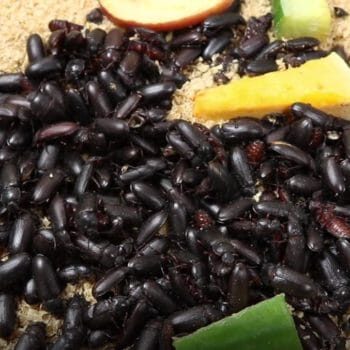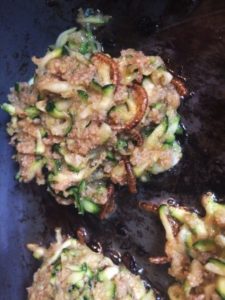How to grow Mealworms

Life Cycle of a Mealworm
Before starting our mealworm farm, I didn’t know the first thing about mealworms. I knew they were golden-brown, and looked like a worm, but that was about it. I didn’t even know there was 4 stages to a mealworm’s life! Metamorphosis is the natural process mealworms use to change themselves physically, just like butterflies and caterpillars! After a slow process of figuring out how to maintain a mealworm in captivity, here is what I learnt about each stage of the mealworm cycle.
Stage one – The Egg
Like lots of creatures, the first cycle of a mealworm is the egg. The eggs are an exceedingly small white oval shape and can take anywhere between 4 and 18 days to hatch.
Stage 2 – The Mealworm
When the mealworms first hatch, they are extremely tiny and super cute. The mealworm (or Larvae) is most active in this stage of its life, they will be eating lots of nutritious foods and wriggling around lots. The Larvae can live up to 9 months in this stage, however they will only stay like this for around 10 weeks in the mealworm hive/farm.
Stage 3 – The Pupae
The Pupae is the next stage after the mealworm. The pupae are weird because even though they are alive, they do not eat, and they keep their moving to a minimum. They look fairly similar to a mealworm and are only stay in this stage for 6-18 days.
Stage 4 – The Beetle
The beetle is the last stage in a mealworms life cycle. The beetle will hatch from the pupae and spend its time laying eggs to continue the cycle. Beetles can live up to 2-3 months, however it is expected that around 50% will die within 2-4 weeks.
Feeding your Mealworm
When it comes to food, mealworms are just like us! They like new and fresh food everyday to get the nutrients they need. Taking out moldy or old food straight away is important in a mealworm farm/hive because the mealworms will not eat it, and it will just stink out the environment.
Variety is vital in feeding a mealworm, just like us, they will get sick of the same food every day. So, giving them a variety of fruits and vegetables will give them the vitamins and minerals they need. Whilst fruit and vegetables are tasty, mealworms also enjoy oats or wheat to eat throughout the day (this is also a great bedding idea!).
Mealworms are like vegetarians! They do not eat meat, fish, eggs, or dairy of any sort. So, it is important to stray away from these foods.
Although mealworms need water, you do not need to give them this directly. They get all the water they need from their food. Which is why it is important to be feeding them fresh foods only. This means there is more water for us, YES!
Why are they so good?
Mealworms are good for 2 different reasons. Firstly, they are really good for the environment and composting, but they are also good for our nutrients and protein intake.
Food waste is a great meal for the mealworm – the mealworm is a great food (protein) for animals and humans – mealworm byproduct is dry powder and makes great plant food – plants are new food for animals and humans.
I know it might seem strange to eat a mealworm! But mealworms are a fun and fast way to consume the protein our body needs. I’m not saying you should go dig up the garden to find a mealworm for dinner…. But when a mealworm is grown properly, like in a hive or farm, you can cook them and use them in basic cooking for this purpose.
Scientists find that mealworms may be one of the most effective way of taking action against the plastic waste problem. Mealworms can actually consume plastics and turn them into carbon dioxide rather than passing them through their feces, how convenient is that! Housing a mealworm farm is also a great way of properly disposing your cut offs and cooking waste. This is a great way of composting and preventing the bin from smelling…. Yuk!
Cooking your Mealworms
Incorporating your farmed mealworms into your daily cooking routine is a great way to absorb the protein your body needs. You can do this by freezing your mealworms and adding small doses into your basic cooking recipes.
Freezing your mealworms is best done straight after a harvest. You can do this by adding some mealworms into a zip lock bag and leaving them to freeze several hours before cooking (minimum of 5). *This is not killing them in a harmful way, they will go into a winter hibernation and die without stress. By adding your frozen mealworms to a hot pan (without oil) you can prep them for cooking.
You can eat your mealworms one of two ways. Firstly, you can simply fry them in a hot pan and eat them jut like that, or you can continue this and add them to a basic meal. Check out these mealworm Zucchini Pancakes! Mmm Yum!
Mealworm Zucchini Pancakes recipe – Feeds 2
(livin farms recipe – Katherina. H)

Ingredients:
- 1-2 zucchinis
- 1 small chopped up onion
- 50g frozen mealworms
- 3 tablespoons flour/breadcrumbs
- 1 teaspoon salt
- 1 egg
- 1 clove of garlic
- Pepper
- Vegetable oil
- 100g of grated cheese (optional)
Method:
- Grate the zucchini and add salt. Wait a few Minutes and pour out the water.
- Add chopped onion and mix.
- Add egg, breadcrumbs, crushed garlic, and pepper (and grated cheese) and mix thoroughly.
- Put frozen mealworms into the hot pan without oil and wait until they do not move anymore (they are dead, it is just the expanding water that makes them wriggle).
- Then take them out and carefully add them to the already mixed zucchini dough.
- Heat a large pan with vegetable oil and put in the frozen mealworms. Take tablespoons full of the zucchini dough, put them in the pan and flatten them a little.
- Turn them over carefully when the bottom starts getting brown. When both sides are crispy put them on a paper towel to drip off some oil.
Yum yum, bon Appetit!
– Aimee
